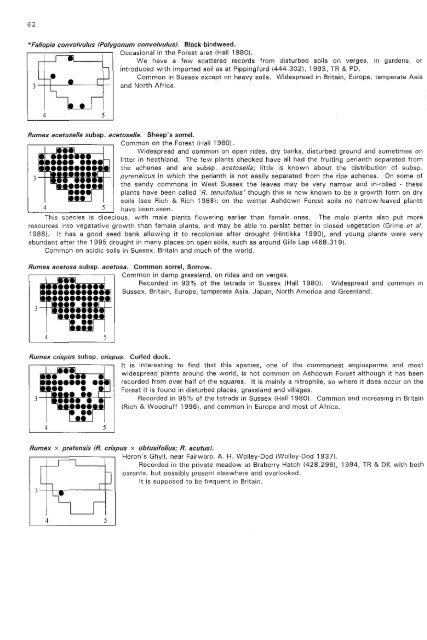Flora of Ashdown Forest - Botanical Society of the British Isles
Flora of Ashdown Forest - Botanical Society of the British Isles
Flora of Ashdown Forest - Botanical Society of the British Isles
Create successful ePaper yourself
Turn your PDF publications into a flip-book with our unique Google optimized e-Paper software.
62*Fal/opia convolvulus (Polygonum convolvulus). Black-bindweed.Occasional in <strong>the</strong> <strong>Forest</strong> area (Hall 1980).We have a few scattered records from disturbed soils on verges, in gardens, orintroduced with imported soil as at Pippingford (444.302), 1993, TR & PD.Common in Sussex except on heavy soils. Widespread in Britain, Europe, temperate Asia3 -++------'''"----'-+__ and North Africa.4 5Rumex acetosella subsp. acetoseJ/a. Sheep's sorrel.Common on <strong>the</strong> <strong>Forest</strong> (Hall 1980).Widespread and common on open rides, dry banks, disturbed ground and sometimes onlitter in heathland. The few plants checked have all had <strong>the</strong> fruiting perianth separated from<strong>the</strong> achenes and are subsp. acetosella; little is known about <strong>the</strong> distribution <strong>of</strong> subsp.pyrenaicus in which <strong>the</strong> perianth is not easily separated from <strong>the</strong> ripe achenes. On some <strong>of</strong><strong>the</strong> sandy commons in West Sussex <strong>the</strong> leaves may be very narrow and in-rolled - <strong>the</strong>seplants have been called 1 R. tenuifolius' though this is now known to be a growth form on drysoils (see Rich & Rich 1988); on <strong>the</strong> wetter <strong>Ashdown</strong> <strong>Forest</strong> soils no narrow-leaved plantshave been seen.s species is dioecious, with male plants flowering earlier than female ones. The male plants also put moreresources into vegetative growth than female plants, and may be able to persist better in closed vegetation (Grime et al.1988). It has a good seed bank allowing it to recolonise after drought (Hintikka 1990L and young plants were veryabundant after <strong>the</strong> 1995 drought in many places on open soils, such as around Gills Lap (468.319).Common on acidic soils in Sussex, Britain and much <strong>of</strong> <strong>the</strong> world.Rumex acetosa subsp. acetosa. Common sorrel, Sorrow.Common in damp grassland, on rides and on verges.Recorded in 93% <strong>of</strong> <strong>the</strong> tetrads in Sussex (Hall 1980). Widespread and common inSussex, Britain, Europe, temperate Asia, Japan, North America and Greenland.J4 5Rumex crisp us subsp. crispus. Curled dock.It is interesting to find that this species, one <strong>of</strong> <strong>the</strong> commonest angiosperms and mostwidespread plants around <strong>the</strong> world, is not common on <strong>Ashdown</strong> <strong>Forest</strong> although it has beenrecorded from over half <strong>of</strong> tr_e squares. It is mainly a nitrophile, so where it does occur on <strong>the</strong><strong>Forest</strong> it is found in disturbed places, grassland and villages.Recorded in 95 % <strong>of</strong> <strong>the</strong> tetrads in Sussex (Hall 1980). Common and increasing in Britain(Rich & Woodruff 1996), and common in Europe and most <strong>of</strong> Africa.Rumex x pratensis (R. crispus x obtusifolius; R. acutus).Heron's Ghyll, near Fairwarp, A. H. Wolley-Dod (Wolley-Dod 1937).Recorded in <strong>the</strong> private meadow at Braberry Hatch (428.296), 1994, TR & DK with bothparents, but possibly present elsewhere and overlooked.It is supposed to be frequent in Britain.4 5
















